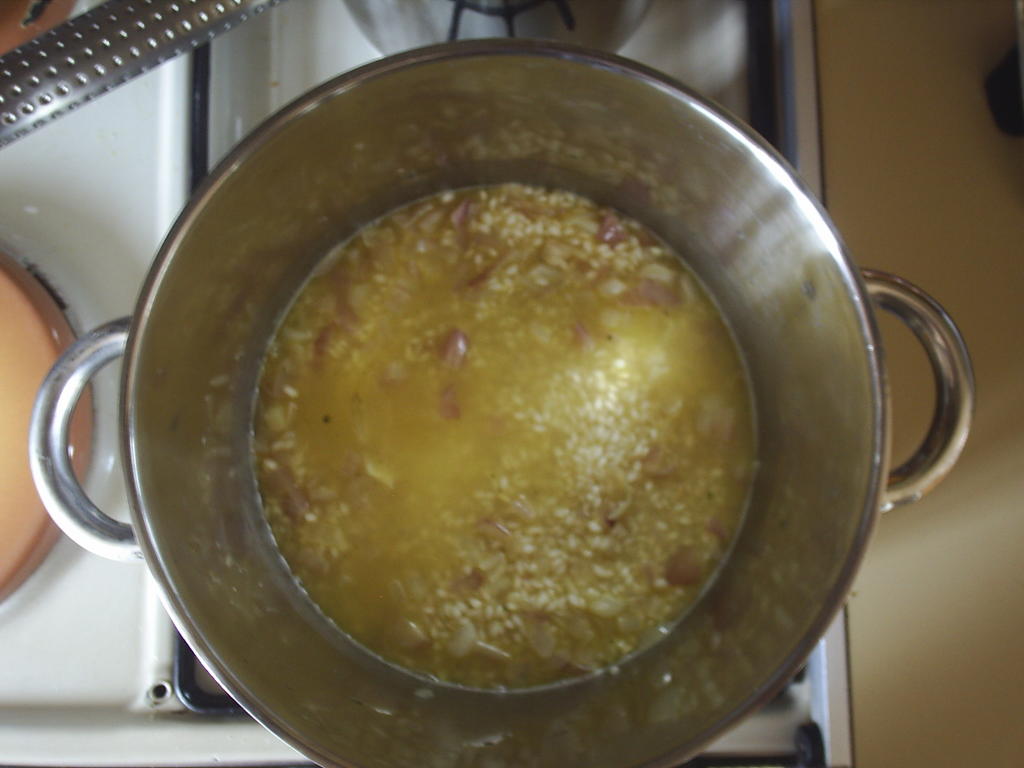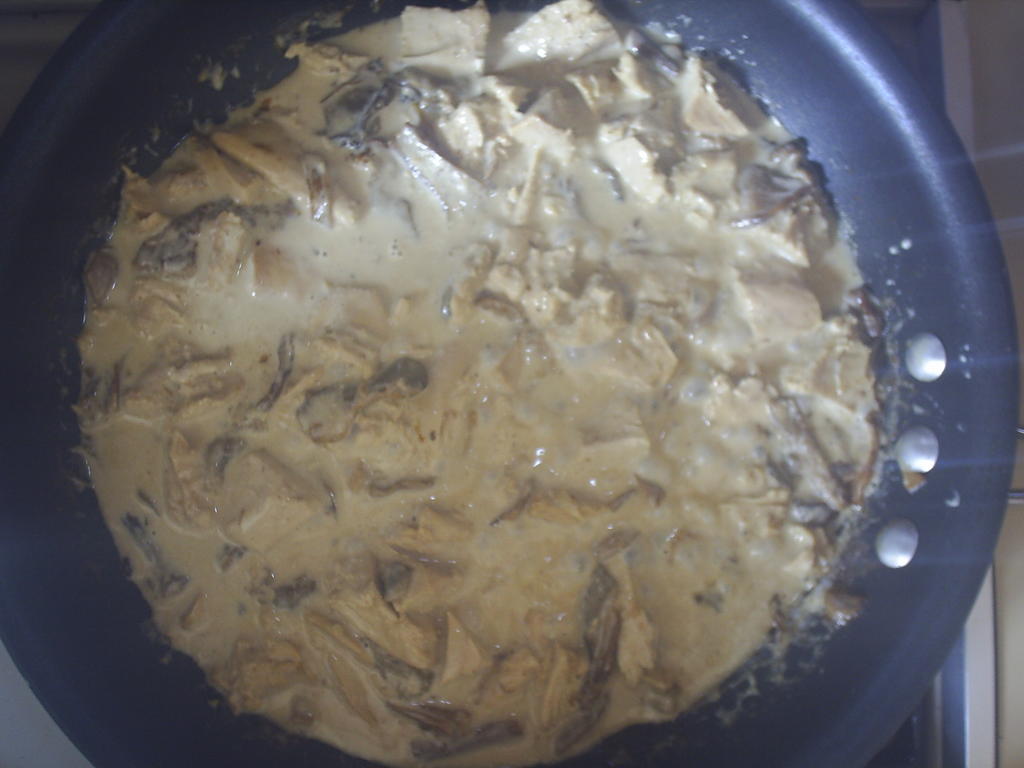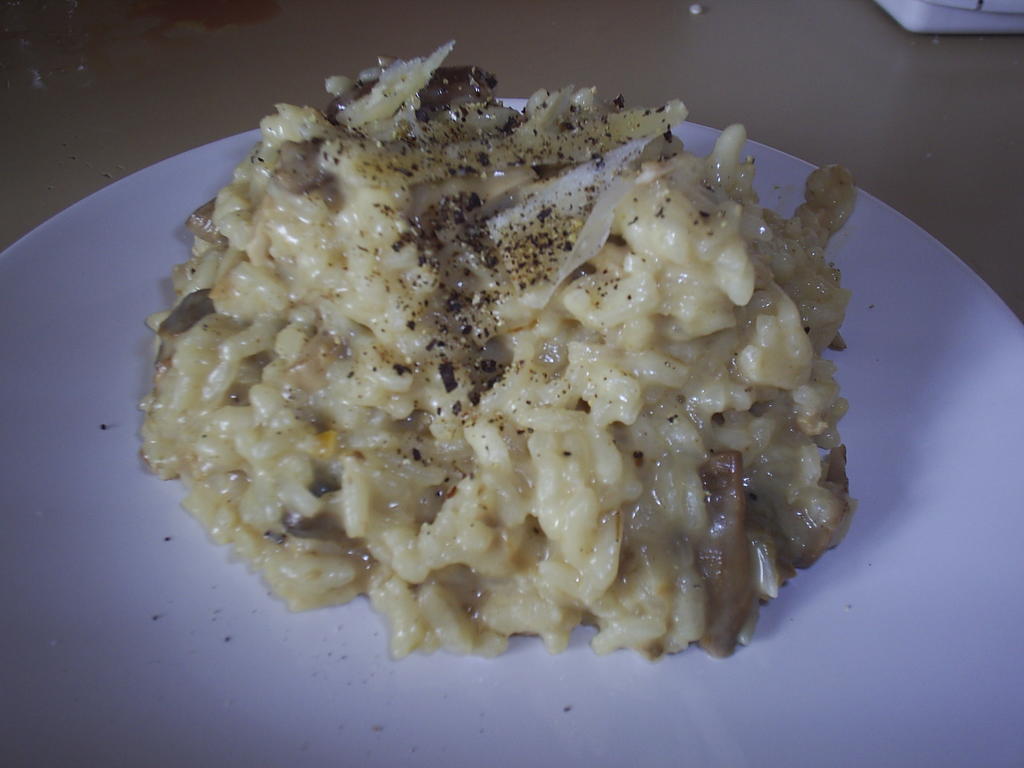Thursday, August 11, 2005
Guinea-fowl and cep risotto
On my way back from work, I popped into the halal abattoir in my village to pick up a 'côte de boeuf', but instead I noticed a batch of fresh farmyard guinea-fowl which incited me to immediately revoke my desire for a bloody, tender side of beef. But as the chap in front of me was either feeding a rather large family or having a lad's night in, I had ten minutes or so to debate whether I was more into big fat pieces of juicy red meat or the very game-like king of poultry in a demi-glace creamy sauce with mushrooms!
I decide for the latter, as I have no ingredients to make a sauce for the beef.
Here we go: easy to make, not at all work intensive (I had at least seven 50cl cans of 1664 whilst making it(thirsty work)) but you have to pop into the kitchen every four or five minutes to keep an eye on things, notably the risotto where a presence is definately required for the last four minutes.
Preheat the oven to about 60°C.
Put the plucked and gutted guinea-fowl in a small baking tray after having rubbed it with duck or goose fat (butter will do if you don't have any fat) and grind salt and pepper on both sides. Pop a an onion or a couple of shallots into the baking tray, too.
Cover it with aluminium foil and expect it to cook for around two and a half hours. check every fifteen minutes or so after an hour and a half to check that it is ok and not overcooked as it will require at least another fifteen minutes browning without the aluminium (this reduces the fat content as well).
The big time-saver and stress-free factor is to prepare ALL of the ingredients beforehand i.e. no last-minute panicking.
Ingredients:

 1 Guinea-fowl
1 Guinea-fowl
300g Arborio rice
1.5l Chicken stock
400ml Veal stock
1 big shallot
1/2 a pot of dried ceps
(use fresh ones when in season)


80-100g Parmesan
10cl cream
fat and/or butter
salt and pepper
1 onion


Put about 15g of butter into a pan and heat it at a low temperature until hot. Add a finely chopped shallot (in this case it was not so fine, but anyway..). After a minute or so add the rice, and stir until it becomes translucent (If it sticks add more butter, or olive oil if it is an emergency).


At this point I would normally add a glass of white wine, which unfortunately I didn't have so I set the stopwatch for eighteen minutes and added a decent cup's worth of chicken stock (If you can be bothered to boil the bones for several hours, you can make guinea-fowl stock for your next one!!)


Stir regularly adding a large cup of stock each time there is almost no liquid left (if you are intending to drink in the meantime, add more stock). When you reach the last four minutes, assess whether or not you should increase the heat (if it is too liquid) or to pour in some more stock (if it is too dry). Relatively logical. It doesn't have to be EXACTLY eighteen minutes. Less is better as it will continue cooking when the heat has been turned off (some chefs do it for fifteen minutes - it depends what you intend to mix it with). Make sure that it is not too dry as it will continue drying out so long as it is warm. This can be remedied by adding more stock. Mix in the parmesan and cover.


Whilst preparing the risotto mix the rehydrated, washed ceps with the veal stock and simmer for a few minutes so that it infuses. I would also have sloshed in another half-a-glass of white wine here too... Pour this sauce into a big, non-stick frying pan and reduce at a medium to high flame to demi-glace, so that it starts to become syrupy and add small, skinless pieces of meat (I only used the white meat for this one as the red meat is much stronger in flavour). Add the cream and reduce until it becomes particularly creamy.

Mix everything together, et voilà!
One thing is for sure, it took me longer to do this article than it did to make the risotto...
I decide for the latter, as I have no ingredients to make a sauce for the beef.
Here we go: easy to make, not at all work intensive (I had at least seven 50cl cans of 1664 whilst making it(thirsty work)) but you have to pop into the kitchen every four or five minutes to keep an eye on things, notably the risotto where a presence is definately required for the last four minutes.
Preheat the oven to about 60°C.
Put the plucked and gutted guinea-fowl in a small baking tray after having rubbed it with duck or goose fat (butter will do if you don't have any fat) and grind salt and pepper on both sides. Pop a an onion or a couple of shallots into the baking tray, too.
Cover it with aluminium foil and expect it to cook for around two and a half hours. check every fifteen minutes or so after an hour and a half to check that it is ok and not overcooked as it will require at least another fifteen minutes browning without the aluminium (this reduces the fat content as well).
The big time-saver and stress-free factor is to prepare ALL of the ingredients beforehand i.e. no last-minute panicking.
Ingredients:

 1 Guinea-fowl
1 Guinea-fowl300g Arborio rice
1.5l Chicken stock
400ml Veal stock
1 big shallot
1/2 a pot of dried ceps
(use fresh ones when in season)


80-100g Parmesan
10cl cream
fat and/or butter
salt and pepper
1 onion


Put about 15g of butter into a pan and heat it at a low temperature until hot. Add a finely chopped shallot (in this case it was not so fine, but anyway..). After a minute or so add the rice, and stir until it becomes translucent (If it sticks add more butter, or olive oil if it is an emergency).


At this point I would normally add a glass of white wine, which unfortunately I didn't have so I set the stopwatch for eighteen minutes and added a decent cup's worth of chicken stock (If you can be bothered to boil the bones for several hours, you can make guinea-fowl stock for your next one!!)


Stir regularly adding a large cup of stock each time there is almost no liquid left (if you are intending to drink in the meantime, add more stock). When you reach the last four minutes, assess whether or not you should increase the heat (if it is too liquid) or to pour in some more stock (if it is too dry). Relatively logical. It doesn't have to be EXACTLY eighteen minutes. Less is better as it will continue cooking when the heat has been turned off (some chefs do it for fifteen minutes - it depends what you intend to mix it with). Make sure that it is not too dry as it will continue drying out so long as it is warm. This can be remedied by adding more stock. Mix in the parmesan and cover.


Whilst preparing the risotto mix the rehydrated, washed ceps with the veal stock and simmer for a few minutes so that it infuses. I would also have sloshed in another half-a-glass of white wine here too... Pour this sauce into a big, non-stick frying pan and reduce at a medium to high flame to demi-glace, so that it starts to become syrupy and add small, skinless pieces of meat (I only used the white meat for this one as the red meat is much stronger in flavour). Add the cream and reduce until it becomes particularly creamy.

Mix everything together, et voilà!
One thing is for sure, it took me longer to do this article than it did to make the risotto...
